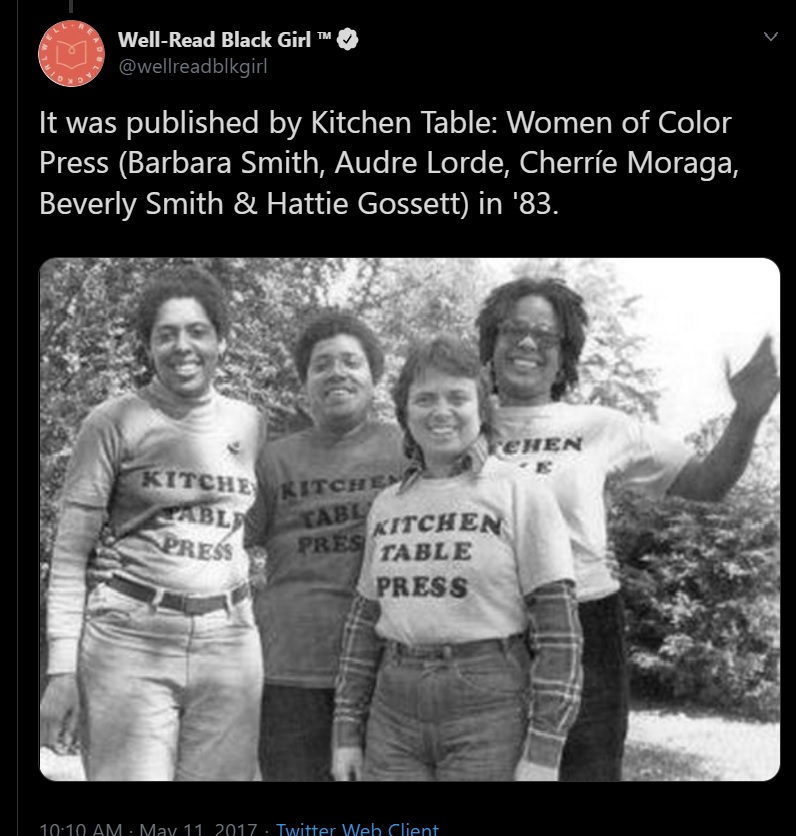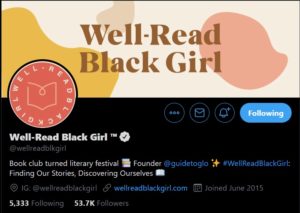Women of Color Feminisms: Unseen Digitized Labor and Activism
I found Cassius Adair and Lisa Nakamura’s piece, “The Digital Afterlives of This Bridge Called My Back: Women of Color Feminism, Digital Labor, and Networked Pedagogy” to be incredibly thought provoking. For one, it made me realize I never really stopped to consider legal “fair use” laws, the labor theft of women of color, and internet consumption in the same vein, before this class. It made me contextualize my social media content consumption, along with giving me hope for how these platforms can be used in the future.
Kitchen Table Press was badass. Sorry if that kind of language is prohibited, but not that sorry. These women (pictured below) founded their own publishing press to protect their intellectual theories, ideations, and stories. It was an invention of survival and struggle. These Black and Brown women participated in the creation of a safe space for the longevity of their geniuses. Adair and Nakamura write, “by reflecting, writing, and speaking about the struggles of producing and circulation This Bridge, the members of Kitchen Table Press aligned their emotional, intellectual, and distribution activities as labor” (265). These women fought for their own structure of publishing and reclaimed the metaphysical, mental, and emotional labor, along with the academic production of their own works.

“It was published by Kitchen Table: Women of Color Press (Barbara Smith, Audre Lorde, Cherrie Moraga, Beverly Smith, & Hattie Gosset) in ’83).
The image I have inserted above of Barbara Smith, Audre Lorde, Cherrie Moraga, Beverly Smith, & Hattie Gosset is a widely circulated image that pops up, if you Google, “kitchen table press.” However, I use this screen grab intentionally. This picture was tweeted by the Twitter account @wellreadblkgirl. I had no idea this page existed. I attached a link attached to the image below, which describes the bio of the page, if folks want to check it out. The bio reads, “Well-Read Black Girl: Book club turned literary festival…Finding Our Stories, Discovering Ourselves.” I include this and point out that this account tweeted the image of the Kitchen Table Press because I feel like it’s a perfect example of the coincidence of This Bridge and digital consumption and activism. Black women and other women of color can utilize platforms to bend to their principles and lived experiences detailed in these scholarly works, while educating and sharing with the masses. It also allows for younger women to be empowered by these examples and to see issues surrounding race, gender, sexuality and other intersections of identity to be topics which they can theorize and discuss as well. These kinds of accounts and platforms dismantle the monolith of academia. However, Twitter is another coroporate conglomerate which stands to gain compensation, as opposed to the individual. I wonder what alternative, non-corporate platforms of sharing these kinds of thoughts can be imagined to look like.
While this is a much more complicated issue of the violent history of uncompensated labor and practice against women of color, this kind of knowledge dissemination and creation of networks allows for a new understanding of how education like third world feminisms can reach the “global cultural flow,” as anthropologist Arjun Appadurai calls it. I remember learning about his theory of “technoscapes” in one of my anthropology classes., where he uses it to describe and understand the global economic and cultural flow through different disseminations of knowledge. His term is one in which the increasing speed and advancement of technology can help understand the “increasingly complex relationships between money flows, political possibilities, and the availability of both low and highly-skilled labor” (Appadurai, 298). This can help us better understand how Adair and Nakamura characterize the “Internet [as] animated by cultural and technical labour” structures (263). This is not just a phenomenon limited to America or women of color feminists within the States. The Internet is just a paradoxical example of simultaneous (in)/visibility of the theft of labor and labor divisions created for people of color across the world.
However, as I end my post of rambles, I wonder if a hegemonic Black feminist and third world feminist discourse can be created with the Internet. Edward Said’s Orientialism relies on European hegemony being consolidated through the constant circulation of Western scholarly discourse. Taking “technoscapes” into consideration, a Black/women of color feminism hegemony is not impossible with the use of social media. I use the word hegemony because my vocabulary currently lacks the vernacular to describe a dominant society based on the principles of revolution and freedom. While I understand this issue is way more nuanced than the points I offer, I wonder and yearn to be part of that kind of world. If only…


